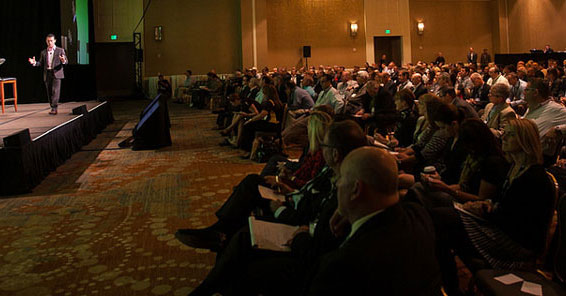New Horizons: Nontraditional locations go where the guests are

Steve Lieber, vice president of business development for BurgerFi and Anthony’s Coal Fired Pizza & Wings, met an entrepreneur who got into the movie theater business so that he and his friends could watch Bollywood films. The Apple Cinemas team was looking for a distinctive edge in the marketplace.
After Lieber’s boss gave him the go-ahead to explore nontraditional locations in the wake of the pandemic, Lieber sent out an email blast to his contacts, and Apple Cinemas was ready to do business.
“We did BurgerFi in the movie theater in Pittsburgh,” Lieber says, “and then they asked if we could come up with a pizza element.”

It doesn’t make sense to put a coal-fired oven in a movie theater, so the team must be flexible to make the new partnership work. “We want to use the same flour, the same tomatoes, the same cheese, and things that our guests are used to but cooked in a slightly different oven,” Lieber says.
Nontraditional locations can offer franchisors new ways of reaching customers, but they have pros and cons. Space can be limited, reducing the number of menu items available. By necessity, restaurants in theaters, amusement parks, college campuses, and stadiums have different operating hours than traditional locations. And getting supplies and people through airport security each day requires an experienced hand.
However, there are upsides to putting restaurants where people will find them. According to a report from the National Association of Convenience Stores, inside-store foodservice sales accounted for $277.9 billion in 2021. Airport Improvement magazine reports that HMS Host has licenses to operate franchises in the busiest airports in North America and brings in $2.8 billion each year. The post-pandemic reality is people are on the move again. Clearly, there’s money to be made in nontraditional locations.
“It’s based on that trend of the guests wanting our food where they’re at,” Lieber says, “so we said, ‘Okay, where are they?’”

2 “stage gates”
Tom Richards, VP of nontraditional sales at GoTo Foods (formerly Focus Brands), represents Auntie Anne’s, Cinnabon, Jamba, Carvel, Moe’s Southwest Grill, McAlister’s Deli, and Schlotzky’s.
“We do work across all seven brands in our portfolio,” he says. “I feel very blessed to have a portfolio like this to be able to work across a wide array of different nontraditional channels.”
He and his small but experienced team take an anywhere-and-everywhere approach to nontraditional locations. They’re working to get restaurants in travel centers and convenience stores across the country. They’re also doing business with Walmart, Meijer, and others. Military bases and airports are in the plan as well.
“Colleges and universities, amusement parks, and casinos are probably where we currently have activity in a meaningful way in our pipeline today,” Richards says.
When considering a franchising or licensing agreement to install one of GoTo Foods’ brands in a nontraditional location, Richards and his team have two “stage gates” to work through: the consumer and the venue.
It’s important to understand the potential customer base that a particular location will serve. Will they be repeat customers? Or will they be unique visitors each day? “If it’s the same customer day in and day out, I’ve got to provide them more variety, so they come back to my brand every day,” he says.
Space is a prime concern when thinking about possible venues, but a seasoned team knows counter and kitchen space don’t tell the whole story. “Do I have a remote preparation or kitchen prep area that I can leverage and allow the franchisee to execute out of that space?” Richards says. “Do I have enough room in the location I’ve been given in the venue to succeed and develop the brand in the proper way?”
Size and shape
The restaurant doesn’t have to change at all when going into a nontraditional location. The owner of multiple Temp-Stop stores in Missouri and Kansas wanted to put Huddle House restaurants in his stores, says Kayla Edidin, senior director of franchise development at Ascent Hospitality Management, Huddle House’s parent company.
“He had heard about Huddle House and loved the reputation and just knew it would add value to his convenience store business,” Edidin says. “Really, what he’s looking to do is keep people on his property longer and give them reasons to come in beyond gas.”
The first location of the deal is being constructed in Sedalia, Missouri, and it’ll be a full-sized Huddle House with a 2,000-square-foot footprint. However, the team at Ascent is developing prototypes for smaller Huddle House and Perkins Restaurant & Bakery locations that can be used in both traditional and nontraditional locations, according to Peter Ortiz, chief development officer at Ascent Hospitality Management.

“We’re in the midst of creating smaller footprints of approximately 1,500 square feet that would go into a lot of these travel plazas, universities, airports, you name it,” Ortiz says.
Jon Fischer can talk up the tasty treats from Wetzel’s Pretzels until mouths water. As head of development at Wetzel’s, he has a lighthearted zeal for getting pretzels to the people. Part of that strategy involves putting a full bakery on wheels, so food trucks can reach customers wherever they congregate.

“When I joined five years ago, I would say we were still primarily a mall-based company,” Fischer says. “That wasn’t long before Covid hit.”
The company has corporate stores in Disneyland and Disney World. They also have locations at the University of California Los Angeles campus and in a few airports, so Wetzel’s had a comfort level with nontraditional locations.
“We’ve done some military bases,” he says, “and we’ve done some with travel plazas and just regular convenience stores.”
When he started with the company, about 90% of locations were traditional. He estimates that number to be 70% today. He expects nontraditional growth to outpace traditional because space is limited in the nation’s premier malls.
“When I joined the company, we were just testing one food truck,” he says. “Today, we have approximately 25 food trucks on the road and several more in development. Last year, we had at least four owners buy their second food truck.”
Part of the appeal is the truck’s flexibility, he says. If there’s not enough business in one location, try another. Owners find places in their territories and communities that work for them, and they can take their distinctive yellow Wetzel’s Pretzels food trucks to carnivals, schools, and special events. Last year, a truck was set up outside the Rose Bowl, and NASCAR fans got to bite into pretzels on race day.
“We have trucks in Texas. We have trucks in Maryland. We have trucks in Florida. Right now, we’re opening the truck in the panhandle of Idaho,” he says. “We’re bringing pretzels to the people.”
On the menu
The Wetzel’s food trucks are full bakeries on wheels, so the menu doesn’t have to change. But nontraditional locations often require simplified offerings to increase operational efficiency and transaction speed, reducing the time customers stand in line.
“You want to reduce the number of ingredients just to be logical,” says Richards with GoTo Foods. “What can we make with the same ingredients? What are the most versatile sandwiches? But you’re also asking, ‘What are the favorites?’”
When it comes to menus, Richards says brand integrity should remain intact. “For example, at McAllister’s Deli, you’ve got sandwiches, you’ve got salads, you’ve got spuds,” he says. “We’ll make sure that we have each one of those categories represented well.”
It might seem obvious to shrink the restaurant menu in an airport because people are on the go. Grab-and-go food is an airport necessity, but some people believe in arriving early for their flights, and those flights can be delayed.
“In the post-9/11 world, we have a little bit longer dwell times in airports where a customer has an opportunity to get there early and enjoy a meal before they actually get to the gate,” Richards says.
For Ascent’s deal with Temp-Stores in Kansas and Missouri, the whole point was to put a full-sized Huddle House into the stores. It won’t be a 24-hour business, but the menu doesn’t change. However, part of building smaller prototypes for Huddle House and Perkins involves getting clear about what stays on the menu and what goes.
“We’re preparing menus to take advantage of that size,” Edidin says. “With Perkins, the menu that we’ve created recently is slightly different from restaurants. It’s more grab and go and fewer entrees.”
Again, brand integrity matters. Both Huddle House and Perkins have reputations as breakfast restaurants. “I’m a waffle guy,” Ortiz says. “We’re going to have the comfort food people expect.”
Partners
Ortiz and Natalie Hansen, senior director of franchise development at Ascent Hospitality Management, have developed nontraditional locations for other brands, so they have existing relationships. They want the prototypes and menus to be 100% ready before beginning their full-court press for new locations.
“You’ve really got to come prepared when you’re coming to talk to some of these bigger players because they can choose from hundreds or thousands of other restaurant brands,” Hansen says. “We need to have one-on-one scheduled meetings where we can talk to them about how we can benefit them and bring Perkins or Huddle House to the airports, colleges, and wherever they have their concessions.”
Lieber says licensing agreements are more practical than franchise agreements when dealing with concessionaires that operate multiple BurgerFi locations in multiple airports. The company also uses a licensing agreement with Apple Cinemas.
“A licensing agreement is a lot simpler. As you start to roll out more locations, you and I don't have to go back and say, ‘Okay, what's the franchise fee? What's the royalty? What's this? What's that?’” Lieber says. “You just call me and say, ‘Hey, Steve, I have a new location. We're opening up Apple Cinemas number 12. It's going to be in White Plains, New York. Are you guys good with that?’”
When it comes to nontraditional locations, most franchisors rely on concessionaires and food management companies, including HMS Host, Aramark, Sodexo, Compass, Delaware North, and others. NEXCOM, the Army & Air Force Exchange Service, and others become licensing partners for military bases. As Richards says, “They understand the nuances of doing that type of business.”
Airports, military bases, hospitals, casinos, and other nontraditional locations have rules and regulations that aren’t required with traditional locations. Getting people and supplies through airport security each day can present significant hurdles to the uninitiated.
“Regional master concessionaires work directly with minority business enterprises or disadvantaged enterprises,” Richards says. “There are percentage set-asides that the airports require that they fulfill. That’s part of the bidding process in airports.”
GoTo Foods relies on concessionaires and contract management companies for most of their nontraditional locations. However, some independent franchisees have worked with the company to establish restaurants in nontraditional locations. “We’ll definitely work with them, help them find space on a base, and coach them on how to bid the business,” Richards says.

Dave’s Hot Chicken doesn’t have its restaurants in nontraditional locations, but the company sees their potential value. Carolyne Canady, chief development officer and a Dave’s Hot Chicken franchisee, says the company doesn’t plan to work with large concessionaires. Instead, she says they’re looking to team up with owner-operators who will then respond when venues put out requests for proposals (RFPs).
“The way we’re going about it is really talking to experienced owner-operators who are already operating in airports, which is different than going to an airport and saying, ‘Hey, LAX, Dave’s Hot Chicken is interested in bidding on RFPs that might be upcoming,’” she says. “We’re looking for those operators who are already in the airports and want to bring in Dave’s Hot Chicken as one of their brands.”
A small footprint prototype between 800 and 1,000 square feet is available. It could be used for a traditional or nontraditional location, she says.
“We’re actually talking to a couple of people who have reached out to us for a couple of airports, and they’re the perfect fit,” she says. “We’re just kind of starting the process with them, getting them through the process of saying, ‘Yep, we approve you as a franchisee,’ and then we’re ready to go as soon as an RFP hits.”
Pros and cons
Canady says Dave’s Hot Chicken is running out of development room in the U.S., so it makes sense to move the brand and its already streamlined menu into nontraditional venues. “We’ve got the country covered from a traditional standpoint, and now we want to look at some of the nontraditional opportunities for developing, like airports, college campuses, malls even,” she says. “This will be the next phase of development.”
There are potential drawbacks. Richards says some venues, including amusement parks and stadiums, aren’t open 365 days a year, so the number of event days and nights should be taken into account. Since their hours of operation are limited, revenues will be affected.
“It may not cost you a lot to build out a concession stand, but you only have X number of event days to cover that cost and investment. On a college campus, you’ve got 34 to 38 weeks a year that you’re doing business, and that’s typically done five days a week,” he says. “The math has got to be adjusted in order to make sure that you’ve got enough sales to cover the cost of investment and your operating costs.”
Wetzel’s Pretzels food trucks are a relatively new innovation for the company, but the longer they’re on the road, the more likely they are to break down. That means an operator needs to be prepared to fix and replace kitchen equipment as well as deal with tires, brakes, and other vehicle maintenance issues.
On the positive side, the barrier to entry is lower for a food truck than for a traditional build. “If you’re going to go into a brick-and-mortar location, there’s a lot of costs associated with building that out—plumbing and all the things that come with that,” Fischer says. “Our investment ranges vary, but food trucks are on the lower side of investment.”
Franchisors wouldn’t bother with nontraditional locations if they didn’t provide solid ROI for the company, and sometimes, those returns can be far reaching.
Lieber with BurgerFi and Anthony’s Coal Fired Pizza & Wings says the deal with Apple Cinemas has clear upsides. Most people go out to eat before catching a movie, so the partnership provides theatergoers a one-stop location. “They’re trying to give people a reason to get out of their house, away from their big screen TV, and watch it all in their theater,” Lieber says.
And on every movie night, BurgerFi and Anthony’s have the chance to impress because the restaurants are located where the guests are.
Share this Feature
Recommended Reading:
| ADVERTISE | SPONSORED CONTENT |
STAY CONNECTED
Subscribe to our newsletters to stay informed on the hottest trends in Franchising.
FRANCHISE TOPICS
- Multi-Unit Franchising
- Get Started in Franchising
- Franchise Growth
- Franchise Operations
- Open New Units
- Franchise Leadership
- Franchise Marketing
- Technology
- Franchise Law
- Franchise Awards
- Franchise Rankings
- Franchise Trends
- Franchise Development
- Featured Franchise Stories
FEATURED IN

Franchise Update Magazine: Issue 2, 2024
| ADVERTISE | SPONSORED CONTENT |








 The franchise listed above are not related to or endorsed by Franchise Update or Franchise Update Media Group. We are not engaged in, supporting, or endorsing any specific franchise, business opportunity, company or individual. No statement in this site is to be construed as a recommendation. We encourage prospective franchise buyers to perform extensive due diligence when considering a franchise opportunity.
The franchise listed above are not related to or endorsed by Franchise Update or Franchise Update Media Group. We are not engaged in, supporting, or endorsing any specific franchise, business opportunity, company or individual. No statement in this site is to be construed as a recommendation. We encourage prospective franchise buyers to perform extensive due diligence when considering a franchise opportunity.